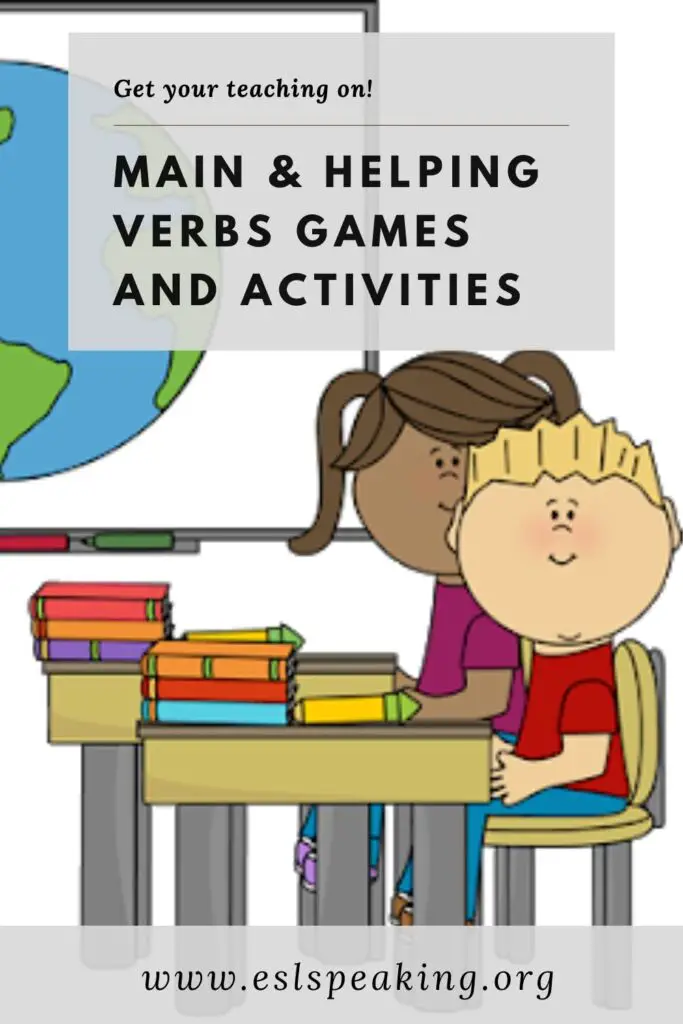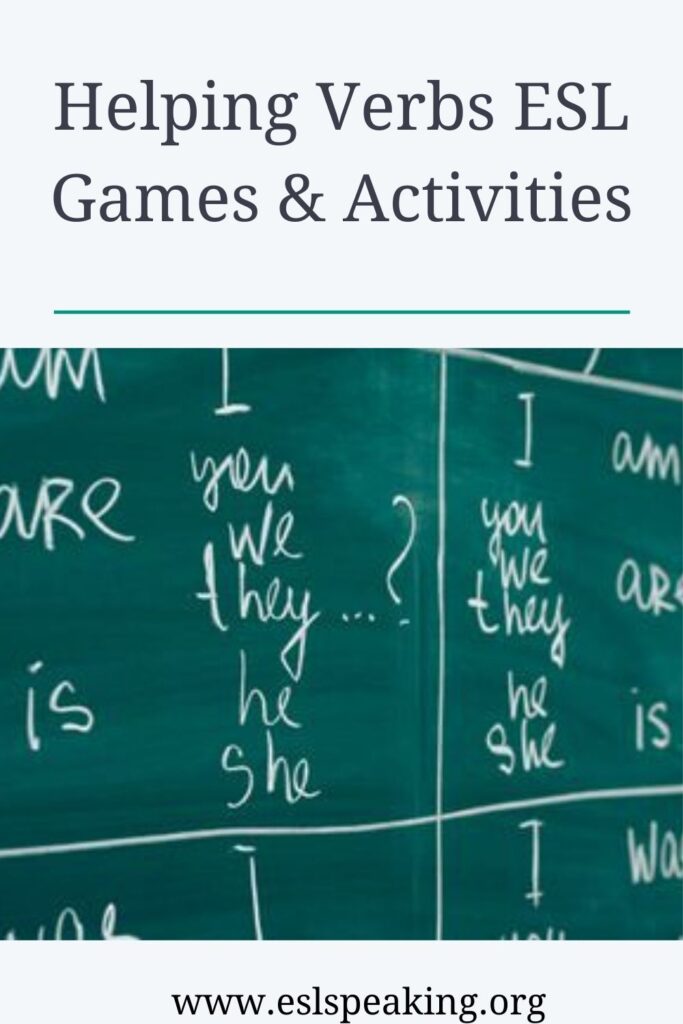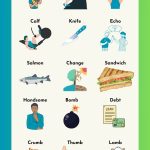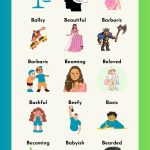If you’re looking for all the best helping verb and main verb activities and games for English learners, then you’re certainly in the right place. Keep on reading for all these linking verb activities, along with worksheets, lesson plans and online practice opportunities.

Helping verb games and activities
Helping Verbs Activities for TEFL
Let’s get into the best main verb and helping verb games and activities to try out with your students today.
#1: Vocabulary Auction
This is an excellent activity to help students build sentences with linking or helping verbs, along with the main verb. Students have to bid on words that can form sentences and then engage in a trading session with their classmates. The team that forms the most complete sentences is the winner.
It certainly does take some preparation time but it’s such a great activity that I don’t mind doing it, particularly if I can recycle it for multiple classes. Just be sure to design the activity well so that students have to use a linking verb and can’t make too many sentences without them. Find out more about it:
ESL Vocabulary Auction Activity.
It can be super helpful to laminate these things so that you can use them again and again. Here are some of our top options: Laminating machines for teachers.
#2: Board Games with Helping Verbs and Main Verbs
I love to play board games in real life so like to introduce my students to them in my classes as well. They’re ideal for reviewing just about anything in a fun way, including helping verbs.
Fill up the board with questions that contain the target helping verbs that you’re teaching. Then, students have to answer the questions using a correct sentence. Or, write down some answers and students have to form a correct question to match. Find out more about how to make them here:
#3: Got to Hand it to You Main and Helping Verb Review
This is a nice way to take something old (error correction) and make it new again by turning it into a fun game. Students have to work together to correct errors in sentences. Of course, many of the errors should be related to main or helping verbs. However, it’s nice to challenge more advanced students with some punctuation or spelling errors too. Check it out:
Got to Hand it to You Error Correction ESL Game.
#4: Relay Race Game
#5: Running Dictation Helping Verb Activity
This is a fun, challenging 4-skills ESL activity that you’ll certainly want to try out with your students. Find, or write a conversation between two people that uses lots of the target helping verbs.
Then, students have to work together to dictate the passage and once done that, they have to put the sentences in the correct order. Find out all the details about it:
Running Dictation 4-Skills ESL Activity.
#6: Dictogloss
This is a challenging listening activity that’s ideal for intermediate or advanced students. Find (or write) a passage filled with lots of sentences that contain helping verbs.
Then, put students into pairs and read out the passage at a faster than normal pace for the level of the students. They can take notes and then compare what they have to try to recreate the passage. Repeat the process 1-2 more times and then at the end, students can compare what they have with the original version.
After that, extend the activity by getting students to underline the main verb and circle the helping verbs. Discuss how the helping verbs change the meaning of the sentence. Find out more details here:
Dictogloss ESL Listening Activity.
#7: Dialogue Substitution
Things like helping verbs are often introduced through a dialogue of some kind. But, have you ever noticed that when you ask your students to read it, they just blow through it without really paying attention to what they’re reading? Mine usually do!
Of course, it’s not the students’ fault. It’s that I haven’t given them a reason to read. If you want to avoid this problem, consider removing some of the important words. This turns it into a meaning, as well as reading focused activity. Try it out:
Dialogue ESL Reading Activity.
#8: Helping Verbs Videos
Maybe your students are kind of like mine and get tired of hearing you talk by the end of the semester? Joking, but only kind of! That’s why I like to let another teacher do the heavy lifting sometimes. There are lots of great instructional videos on YouTube that do a nice job of explaining something like what a helping verb is.
#9: ESL Pronunciation Games and Activities
If a sentence has a linking verb in it, it’s very common for there to be a contraction that should be used when speaking. This means that if students don’t use this, they can sound very far from fluent.
It’s for this reason that I love to focus on pronunciation when teaching students to form sentences using helping verbs. Here are some of the ways that I do this:
English Pronunciation Activities.
#10: Telephone ESL Speaking and Listening Game
This is a fun game to try out with children. Students can line up and then the teacher gives the first student a secret message that students pass down the line from person to person.
Of course, it should contain some of the target linking verbs in it. The last student says the sentence out loud and compares it with the original version. Find out more:
#11: Picture Prompt
This is a nice ESL warmer that can serve as an introduction to helping verbs. For example, you might choose a picture with lots of action in it. Then, ask students what the people are doing. They may say, “walking.” Turn it into a sentence by saying, “The man is walking his dog.”
Or for modal verbs, you might ask what the people can do. There are lots of possibilities, depending on what you’re teaching and the picture chosen. Learn more about it:
#12: Disappearing Text Helping Verb Activity
If you want to focus on forms (some of them can be tricky if they contain linking verbs), try out this simple activity. Write the target sentence on the board and have students read it out loud together. Then, erase some of the words and have students do the same thing. Then, erase more words and continue until there is nothing left on the board but students are saying the sentence. More information here:
#13: Speaking Lesson Plan for Linking Verbs
It’s certainly possible to design your own speaking lesson plan for linking or helping verbs. It’s easier than you might think if you follow a template! Here’s the one that I use in my own classes, loosely based on the CELTA style lesson plan:
Speaking ESL Lesson Plan Template.
#14: Sentence Structure Activities and Games
Time spent working on sentence structure with English learners will never be wasted time! It’s a very valuable use of class time and particularly fruitful for working on linking verbs, which can be a little bit tricky. Here are some of the top ideas for this:
ESL Sentence Structure Activities.

Main verbs and helping verbs
#15: English Drills
Using helping verbs can be a wee bit tricky, especially concerning word order. A nice way to help students out with this is to do some drills in class. Have a look here for some of my ideas:
#16: Helping Verb Charades
Write down various sentences on cards, each missing a helping verb. Students take turns choosing a card and acting out the sentence while their classmates guess the correct helping verb.
#17: Helping Verb Bingo
Create bingo cards with sentences that are missing helping verbs. Call out sentences, and students need to identify the correct helping verb and mark it on their bingo cards.
#18: Helping Verb Puzzles
Create puzzles with sentence fragments. Each puzzle piece contains a part of the sentence, including the helping verb. Students must assemble the puzzle pieces to form complete sentences.
#19: Storyboarding
Provide students with a short story outline or comic strip with speech bubbles that need to be filled in. They can practice using helping verbs while completing the dialogue.
#20: Music and Lyrics
Choose songs with clear examples of sentences using helping verbs. Listen to the song together and have students identify the helping verbs in the lyrics.
#21: Role Play
Create scenarios where students need to use helping verbs in conversations. Assign roles to students and encourage them to incorporate helping verbs naturally.
Main and Helping Verb Worksheets
If you want to give your students some extra practice with identifying these kinds of verbs, check out these worksheets:
ESL Lesson Plans for Helping Verb
If you’re a teacher, then you’ll know how awesome it is to just print off a lesson plan and go to class. It can be a huge time-saver. Here are some of the top recommendations for linking verbs and main verbs lesson plans:
Online Practice for Students with Linking or Helping Verbs
If your students want to get some extra practice with main or helping verbs, there are some great online resources to recommend. Here are some of my favourites:

Helping verb exercises and activities
Main/Helping Verbs FAQs
There are a number of common questions that people about making sentences using these kinds of verbs. Here are the answers to some of the most popular ones.
What is a helping verb?
In English, a helping verb is a verb that comes before the main verb in a sentence. They extend the meaning of the main verb and can also convey time. Helping verbs are needed to form the progressive and perfect tenses in English.
What are some examples of helping verbs?
Some examples of helping verbs can be found in the following sentences:
- He can play soccer (can).
- She was given the top prize (was).
- I am renting out my spare room (am).
How do you find the main verb in a sentence?
To find the main verb in an English sentence, here are a couple of clues:
- The main verb usually comes right after the subject.
- It will also express actions, emotions, ideas, or states of being.
What are the 23 helping verbs?
In English, the 23 helping verbs are as follows: am, is, are, was, were, being, been, be, have, has, had, do, does, did, will, would, shall, should, may, might, must, can, could.
Did you like these Helping Verbs Activities?
- Amazon Kindle Edition
- Bolen, Jackie (Author)
- English (Publication Language)
- 87 Pages - 10/24/2019 (Publication Date)
Yes? Thought so. Then you’re going to love this book over on Amazon: 39 No-Prep/Low-Prep ESL Grammar Activities and Games. The key to better TEFL classes is a wide variety of student-centred, engaging, and interactive ESL games and activities and this book will help you get there in style.
You can find the book in both digital and print formats. Keep a copy on your offwhatice bookshelf to pull it out when planning lessons. Or, take the ebook with you to your favourite coffee shop for a serious lesson planning session on the go.
Whatever the case, get ready for some ESL teaching awesome in your life. Head over to Amazon now to pick up your copy today:
Have your say about these Main/Helping Verb Activities
What’s your top pick for an activity or game that can help students work on main and helping verbs? Is it one of the options from this list or do you have another one that you’d like to recommend? Leave a comment below and let us know what you think. We’d love to hear from you.
Also, be sure to give this article a share on Facebook, Pinterest, or Twitter. It’ll help other busy English teachers, like yourself, find this useful resource for teaching.
Last update on 2024-04-25 / Affiliate links / Images from Amazon Product Advertising API






Leave a Reply